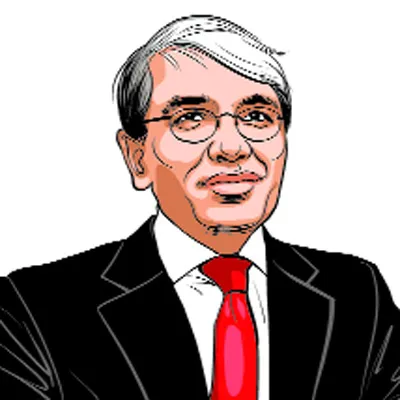Opinion Three flick-of-a-pen reforms chief ministers can make to put India on the path to prosperity
CMs can help raise numbers of high-wage employers by digitisation, decriminalisation and civil service rationalisation
 CMs should implement State Employer Compliance Grids (SECG) replicating the non-profit open architecture technology layer of DPI to facilitate filing periodic returns and issuing licences, registrations, permissions, NOCs, and consent orders.
CMs should implement State Employer Compliance Grids (SECG) replicating the non-profit open architecture technology layer of DPI to facilitate filing periodic returns and issuing licences, registrations, permissions, NOCs, and consent orders. Most employers relate to Bahadur Shah Zafar’s lament, “Umre daraz maangkar laaye the chaar din, do aarzu mein kat gaye, do intezaar mein” (after negotiating a life of four days, two were spent dreaming and two waiting) in their wait for easing of the crushing compliance burden. State governments account for 80 per cent of criminal provisions, 65 per cent of filings, and 63 per cent of compliances for employers. Chief ministers can raise the number of high-wage employers through three flick-of-a-pen reforms: Decriminalising, digitising, and rationalising employer compliance.
History suggests there are no poor people, only people in poor places: Your wages depend on where you live (country, state and city) and where you work (sector, company, and skill). CMs have their plates full of capacity-building (education, healthcare) and institutional (law, infrastructure) reforms. These take years. Legislative or flick-of-a-pen reforms to the one lakh plus compliances/filings/jail provisions foisted on employers may be quicker and impactful because they address irrational workflows, interpretation subjectivity and uncertainty (difference between how the law is written, interpreted and enforced). Let’s dive deeper into these reforms.
Decriminalisation: Eighty per cent of India’s 26,134 employer jail provisions can be removed by CMs. For instance, the innovative Jan Vishwas Bill delivered meagre outcomes — only 110 of 5,239 central employer jail provisions were removed — because of vested interests, a status quo bias, and bureaucratic incentives for no punishment for doing nothing, but hounding for something going wrong (inquiries no longer distinguish between fraud, incompetence, bad luck and bad judgement).
CMs should adopt a “reversing the gaze” philosophy which mandates the removal of all criminal provisions except for three criteria: Physical harm to individuals; intentional fraud against any stakeholder; societal externalities so significant that the violator cannot provide adequate compensation, such as issues related to public order, national integrity, or trust in property rights. There should be no jail provisions in general clauses that don’t specify a crime or define it too broadly as well as in instances of delay or inaccuracies in filings, procedural infractions, incorrect calculations, and wrong formats. These five criteria should be applied retroactively to all existing laws and should become the filter for future legislation and regulations. Jan Vishwas 2.0, coming soon, could eliminate about 40 per cent or the 2,000 plus employer criminal provisions using these criteria. Madhya Pradesh and Tamil Nadu have made small starts, while Gujarat, Karnataka, and Odisha are considering projects.
Digitisation: Sixty-five per cent of India’s 69,233 employer compliances can be made paperless, presenceless and cashless by CMs. India’s unique Digital Public Infrastructure framework has delivered vaccine certificates, highway tolls, de-duplicated welfare records, and payments (RBI’s initial UPI target of a billion monthly transactions has now been revised to a billion daily transactions). Using the DPI framework for compliance got a boost with recent announcements on PAN 2.0 and the EntityLocker (a single source of truth, tamper-proof, and authenticated document repository for all government-issued licenses, registrations, and permissions).
CMs should implement State Employer Compliance Grids (SECG) replicating the non-profit open architecture technology layer of DPI to facilitate filing periodic returns and issuing licences, registrations, permissions, NOCs, and consent orders. SECG would also enable the extraction of distributed and diverse compliance data that currently hinder the government’s ability to sniff defaults, delays and frauds. State grids should connect to national initiatives when they are ready. The DPI framework combines with the new world of software as a service to enable CMs to go live with an SECG in 180 days. SECGs are being considered by Gujarat, Maharashtra, and Andhra Pradesh with varying glide paths for individual department’s back-end integration based on digital maturity.
Rationalisation: Sardar Patel’s steel frame — the civil service — has become a steel cage when India’s needs are shifting from integration and stabilisation to accountability and growth. Many of the 20 million civil servants of state governments inhabit toxic thought worlds where things are prohibited till permitted and people are guilty till innocent.
Civil service reform is complex, so tighter structures are the best place to start. Japan, UK and the US have only 15, 22 and 25 cabinet members, respectively. My guesstimate of government departments are 72 in UP, 63 in Uttarakhand, 54 in Assam, 51 in Punjab and 47 in Madhya Pradesh. This isn’t a big state disease; Maharashtra has 35, Andhra Pradesh has 31, and Gujarat has 27.
The philosopher Karl Polanyi argued that all economic systems are shaped by society, culture, and politics and suggested that well-functioning labour, product and capital markets are hardly inevitable. Prime Minister Modi’s suggestion that 29 chief ministers matter more than one prime minister reinforces Polanyi’s thesis; labour markets are local, and a worm’s eye view of the daily life of entrepreneurs offers more specific, finite and actionable policy insights than a bird’s eye view.
India’s problem of “employed poverty” arises from too many people working on farms, too many self-employed people, too few cities with two to four million people, too few megacities, too few people working in factories, and too few non-farm employers with the productivity to pay higher wages. The best advice for ambitious CMs aiming to deliver the “great transformation” of mass prosperity comes from Nobel Prize-winning economist Daniel Kahneman: “We instinctively step on the accelerator to go faster, but get better results by taking our foot off the brake”.
The writer is with Teamlease Services




